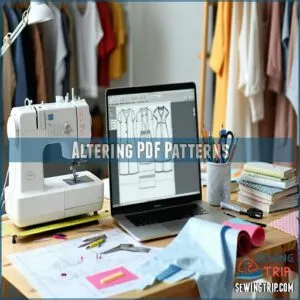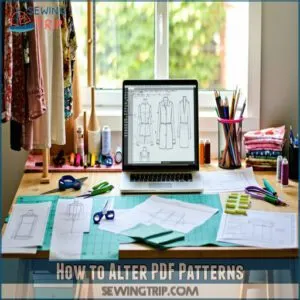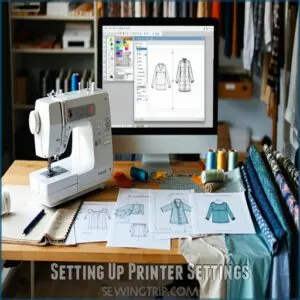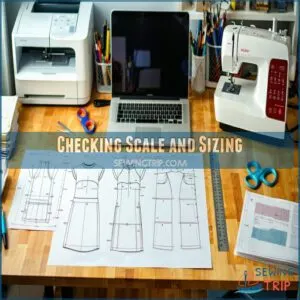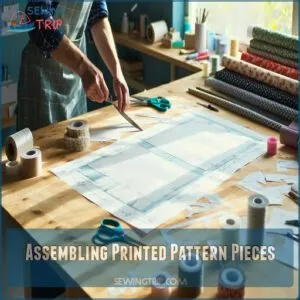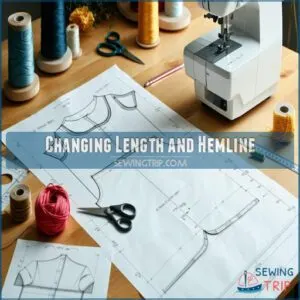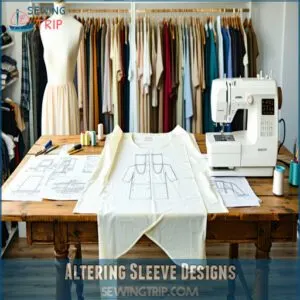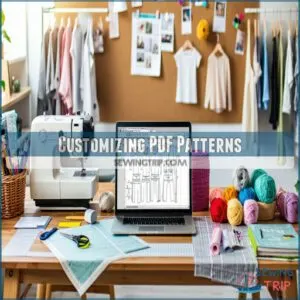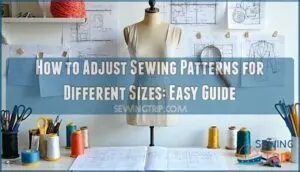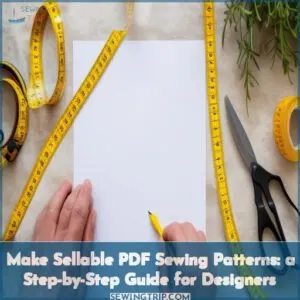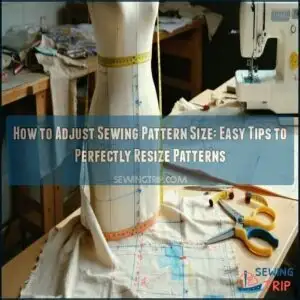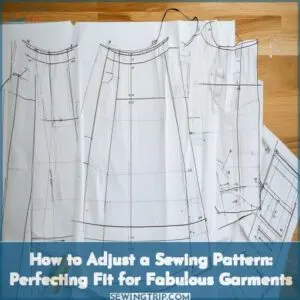This site is supported by our readers. We may earn a commission, at no cost to you, if you purchase through links.
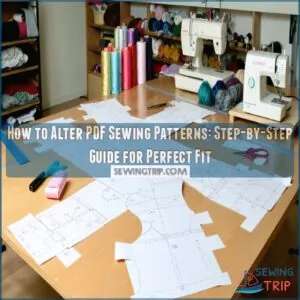
Trim the paper edges and carefully tape the pieces together, making sure lines and symbols align like puzzle pieces.
Identify the areas needing changes—lengthen hemlines, adjust seams, or tweak necklines, and use a ruler to redraw lines, keeping grainlines intact.
Don’t forget seam allowances, and if resizing, use body measurements for precise adjustments, whether you’re adding flair to a sleeve or shortening a dress.
A little tweak here or there can transform your fit and style—like magic, but with scissors, and remember, patience is key.
Table Of Contents
Key Takeaways
- Always print PDF sewing patterns at 100% scale and measure the test square to ensure accuracy before starting.
- Assemble the pattern pieces by trimming edges, matching lines and symbols, and taping carefully for precise alignment.
- Use your measurements to pinpoint where to lengthen, shorten, or reshape, keeping grainlines and seam allowances intact.
- Test your alterations on scrap fabric first and label changes for easy reuse in future projects.
Altering PDF Patterns
Tweaking PDF sewing patterns might sound tricky, but it’s easier than you think with the right steps.
You’ll figure out exactly where and how to make adjustments, so your handmade creations fit perfectly every time.
Understanding Pattern Layout
Understanding the pattern layout is like solving a simple puzzle—it guarantees your pieces fit perfectly.
Always align corners using the provided guides, like circles or triangles, to assemble smoothly.
Keep edges straight, and double-check scaling factors using the test square.
With these drafting basics, you’ll master altering PDF sewing patterns and kickstart your project confidently.
To achieve accurate results, it’s essential to follow proper pdf printing tips to avoid common mistakes.
Patience pays off!
Identifying Modification Points
Now that you’ve studied the layout, it’s time to spot where changes are needed. Look closely for adjustment zones.
- Analyze seams that affect fit (e.g., hips, shoulders).
- Note design elements like darts or pleats needing tweaks.
- Identify areas for length or width alterations.
- Use Fit Assessment to pinpoint Seam Adjustments for pattern modification that’s precise.
Understanding pattern grading techniques is essential for achieving a perfect fit.
Measuring and Marking Changes
Grab your measurement tools and take accurate body measurements—this guarantees precise sewing pattern alterations.
Highlight changes on the PDF pattern using clear notation, keeping grain lines intact. For a seamless fit, note seam allowance adjustments too.
Remember, even minor tweaks while resizing or modifying patterns can make or break your project. Think of it as fine-tuning your blueprint!
How to Alter PDF Patterns
To alter PDF patterns, you’ll need a mix of creativity and precision.
Once you’ve studied the layout, identify changes to fit your style or body. Whether it’s Pattern Hacking or subtle tweaks, the process is straightforward.
Creating sellable PDF sewing patterns requires careful planning and execution. Start with these steps:
- Gather Tools: Grab alteration tools like rulers, pencils, and scissors. A Measurement Guide guarantees accuracy, while sewing tips from pattern instructions can spark ideas.
- Mark Adjustments: Use your measurements to outline edits, such as lengthening or shortening pieces. Think about how fabric choice might affect fit.
- Cut and Edit: Cut pattern pieces carefully and adjust for customizations like additional seam allowance.
- Test on Scrap Fabric: Before committing, test the altered design—a perfect way to avoid surprises.
Sewing pattern alterations are about tailoring creativity to your vision.
Printing PDF Patterns
Printing PDF patterns at home is simple, but it’s all about getting the settings just right.
With a quick test page and careful assembly, you’ll be ready to turn those printouts into your next sewing masterpiece.
Setting Up Printer Settings
When setting up printer settings for PDF pattern printing, choose the right paper size (usually letter or A4) and make sure scaling options are at 100%, or “No Scaling.”
Check page orientation and adjust margin settings if needed. Proper printer calibration avoids surprises.
Master these print PDF patterns tips, and you’ll skip the drama of mismatched pieces! Understanding PDF printer settings is essential for accurate printing results, and following these steps will help you achieve proper printer setup.
Checking Scale and Sizing
To keep your PDF sewing pattern accurate, check the scale before printing everything.
Use the sizing guide on the test page to verify the pattern scale.
- Print a test page and measure the square—should be exactly 1"x1".
- Verify your printer is set to "100%" or "Actual Size".
- Avoid scaling options like “Fit to Page.”
For the best results, follow the print settings guide to confirm accurate printing.
Assembling Printed Pattern Pieces
After checking your scale and sizing, it’s time to bring the puzzle together! Trim the edges where needed, line up those matching corners, and tape the pages with care.
Precision in Pattern Alignment guarantees smoother Piece Assembly later. Think of it as assembling a roadmap—each taped page brings you one stitch closer to perfect pattern alterations.
Understanding pattern grading techniques is essential for creating well-fitting sewing patterns.
| Step | Action | Tip | Tool |
|---|---|---|---|
| 1. | Trim edges | Use sharp scissors | Scissors |
| 2. | Match corners | Align lines carefully | Printed sheets |
| 3. | Tape pages together | Use transparent tape | Clear tape |
| 4. | Confirm alignment | Check for smooth connections | Pattern layout guide |
Modifying Pattern Pieces
When you modify pattern pieces, you’re in control of the fit and style of your garment.
It’s like giving your sewing project a personal touch, whether you’re adjusting a hemline, tweaking sleeves, or reshaping a neckline.
Changing Length and Hemline
Now that your PDF sewing pattern is printed and assembled, let’s talk hemline adjustments and length modifications.
Shorten or lengthen your garment by measuring and marking the pattern pieces. Use sharp scissors and steady hands for pattern alterations.
A sewing technique like hemming tape works wonders for precise edges. Remember, accurate length adjustments make your garment truly custom-fit!
Understanding the change pattern hemline is important for a perfect fit.
Altering Sleeve Designs
Sleeve options can completely transform a garment’s look. Whether adding elegant bell sleeves or playful puff sleeves, pattern alterations for sewing offer endless possibilities.
Here’s how to tweak sleeve designs:
- Add sleeve length or volume with the slash-and-spread method.
- Create cap sleeves or ruffle details by trimming patterns.
- Slim sleeves carefully, ensuring you maintain enough ease for movement to achieve a perfect garment’s look.
Modifying Necklines
Want to change things up? Modifying necklines is an easy way to personalize sewing patterns.
From sleek V neck modifications to dramatic scoop neck alterations or playful asymmetrical cuts, the possibilities are endless.
Simply mark your desired shape on the pattern, ensuring balance and proportion. Don’t forget collar adjustments can elevate design!
With a little imagination, pattern alterations feel empowering. Understanding neckline alteration techniques is essential for a perfect fit.
Customizing PDF Patterns
You can turn any PDF sewing pattern into something uniquely yours by adding personal touches or tweaking small details.
Use the pattern instructions as your guide, and don’t be afraid to let your creativity shine!
Adding or Removing Details
Tweaking a pdf sewing pattern is a breeze! Toggle layers to simplify seam allowance adjustments or pocket addition.
Try altering button placement or notch modification for a clean fit. Need a style upgrade? Fold adjustments can tailor designs instantly.
Sewing pattern editing is like sculpting fabric—modifying sewing patterns lets you create pieces uniquely yours. Get started and alter sewing patterns creatively!
Understanding pdf pattern customization is key to achieving a perfect fit.
Using Pattern Instructions for Guidance
Don’t skip reading those pattern instructions—they’re like a GPS for sewing! They’re packed with gems to guide you.
Instruction tips often include:
- Measurement help for accurate cuts.
- Alteration advice customized for all skill levels.
- Sewing hints to avoid common hiccups.
- Diagrams for assembling pieces.
- Links to pdf sewing tutorials for deeper guidance.
Follow them for stress-free sewing pattern adjustments to ensure a successful sewing experience with clear guidance!
Creating Unique Designs
Creating unique designs with PDF sewing patterns is like painting on a blank canvas.
Mix textures, tweak style fusion, or experiment with bold color schemes.
Explore fabric choices and design elements to make your piece pop.
Use pdf sewing tutorials for guidance or modify sewing patterns for that perfect flair.
Like digital pattern making?
Try pdf pattern editing for endless creativity.
| Technique | What it Does | Tips for Success |
|---|---|---|
| Texture Mixing | Adds depth and interest | Pair bold textures with neutrals |
| Style Fusion | Combines design elements | Balance contrasting styles |
| Fabric Choice | Defines garment’s feel | Consider durability and wear |
| Color Schemes | Creates visual impact | Use complementary shades |
| Pattern Editing | Customizes unique details | Save altered patterns digitally |
The table above outlines various techniques for enhancing your sewing projects, including Texture Mixing, Style Fusion, and Pattern Editing.
By applying these methods, you can create unique and visually appealing garments that reflect your personal style and flair, making use of pdf sewing tutorials and pdf pattern editing for guidance and inspiration.
Finalizing Altered Patterns
You’re almost done, but saving your altered pattern properly guarantees you can use it again without starting from scratch.
Keep everything organized so future you can thank present you for making the process a breeze!
Saving and Storing Altered Patterns
After customizing your PDF sewing patterns, keep things neat with smart pattern storage.
Use labeled envelopes or clear sleeves for printed versions.
For digital pattern files, rely on cloud saving or external drives for secure file management.
Pattern organization is a breeze with archive systems like Trello.
Properly storing altered patterns guarantees they’re ready for your next sewing adventure!
Applying Alterations to Future Projects
Once your PDF pattern alterations are spot-on, you can reuse them like an old favorite recipe. Applied wisely, they’ll save you time and effort.
- Label each pattern clearly with changes and dates.
- Adjust Pattern Scaling if you change fabric types.
- Keep notes on Measurement Guides for repeat projects.
- Combine design variations to spark creativity and refine sewing pattern customization! This will help you to make the most out of your patterns and create unique designs, which is the key to successful pattern alterations.
Frequently Asked Questions (FAQs)
Should I use a PDF form for sewing patterns?
Think of PDF sewing patterns as a trusty sidekick.
They’re convenient, budget-friendly, and endlessly reusable.
You can print, modify, and save space—perfect for customizing projects with ease while keeping everything neatly organized.
What is a PDF sewing pattern?
A PDF sewing pattern is a digital file you can download, print, and assemble at home.
It’s like having a reusable treasure map for creating clothes, minus the guesswork and shipping delays.
Why are PDF Patterns so popular?
You’ll love PDF patterns because they’re instant, affordable, and endlessly reprintable.
No waiting, no shipping costs, and no fear of messing up—just print again!
Plus, they offer incredible size inclusivity and detailed instructions.
How to make a PDF pattern?
Making a PDF pattern is like turning chaos into clarity.
Draft your design on paper, digitize it using Adobe Illustrator, add labels and instructions.
Then export as a PDF.
Voilà—your creative blueprint is ready!
How do I size a PDF file to fit a pattern?
To size your PDF pattern correctly, print the test page first and measure the scale box.
Adjust your printer settings to 100% or "Actual Size."
No shrinking or enlarging—just perfectly matched pieces!
How do I get a free sewing pattern?
You can snag free sewing patterns online by visiting blogs, joining sewing communities, or signing up for designers’ newsletters.
Many offer free patterns as a gift—kind of like a “welcome to the club” bonus!
How to scale down a sewing pattern PDF?
To scale down a sewing pattern PDF, adjust your printer settings to print at a reduced percentage (e.g., 90%).
Always test-print a small section first—nobody wants doll-sized sleeves by accident!
How do I organize my PDF sewing patterns?
Store PDF sewing patterns digitally in organized folders by type or designer.
For printed versions, use binders, hanging files, or envelopes.
Keep them labeled—think “tops,” “dresses,” or “accessories.”
No more rummaging for that perfect pattern to find the one you need, as everything will be well-organized and easily accessible, making it easier to find what you are looking for, with complete concepts at your fingertips.
How do you modify a sewing pattern?
Changing a sewing pattern is like personalizing a blueprint.
You can adjust lengths, reshape necklines, or tweak sleeves.
Use measuring tape, markers, and tracing paper—precision is key, but creativity makes it uniquely yours!
Why is my PDF pattern not printing correctly?
Check your printer settings first—ensure it’s set to 100% or “Actual Size.”
Use a PDF reader like Adobe Acrobat, and don’t forget to print a test page to confirm proper scaling before continuing.
Conclusion
Think of altering PDF sewing patterns like tailoring a story to fit your unique style.
From tweaking hemlines to reshaping necklines, every adjustment brings you closer to the perfect fit.
Remember to measure carefully, keep grainlines aligned, and double-check your seam allowances.
It’s a process that requires patience and creativity, but those little changes can transform your projects.
With practice, you’ll master how to alter PDF sewing patterns and confidently create custom looks that truly feel like you.
- https://www.made-by-rae.com/blog/2017/08/print-assemble-pdf-sewing-pattern/
- https://lifesewsavory.com/how-to-use-pdf-sewing-patterns/
- https://www.myhandmadewardrobepatterns.com/techniques-and-inspiration/mhwpatterns-techniques-how-to-use-pdf-patterns
- https://blog.cashmerette.com/2020/03/how-to-use-pdf-sewing-patterns.html
- https://get.adobe.com/reader/

